
Apr 23
/
Alef Dias
Grains, Oilseeds and Livestock Weekly Report - 2024 04 23
Back to main blog page
Wheat: Russia "triggers" fund coverage
- The headlines coming out of Russia brought significant upward pressure to wheat contracts this week. In addition to the attacks on Ukrainian port infrastructure - which add risks to the transit of grain on the Black Sea - the market began to worry about the deteriorating conditions of the Russian crop.
- Just as we did in our monthly call (which is available on Hedgepoint Hub), other consultancies have also reduced their estimates for Russian wheat production. These were the first cuts in the current cycle, due to deteriorating crop conditions in the south of the country.
- In the coming weeks, the main weather models predict 60-90% of normal rainfall in the South, which, combined with high temperatures, will probably not significantly improve the availability of moisture for plants in the region.
- Although the impact on crop estimates is still limited, there is still room for a significant deterioration of the Russian crop if the weather continues to be negative. The winter crop won't be harvested until July, and the spring crop will be planted next month.
Introduction
The week began with significant rises in wheat futures contracts. In a market that is extremely short on contracts traded in Chicago, bullish fundamentals can be boosted by moves to "cover" these short positions - and the headlines coming out of Russia seem to have succeeded in starting this movement.
In this report, we'll look at one of the main reasons behind the recent rise: the production estimate cuts for Russia's 24/25 harvest.
Fig. 1: Speculative funds positioning HRW wheat (thousand lots)
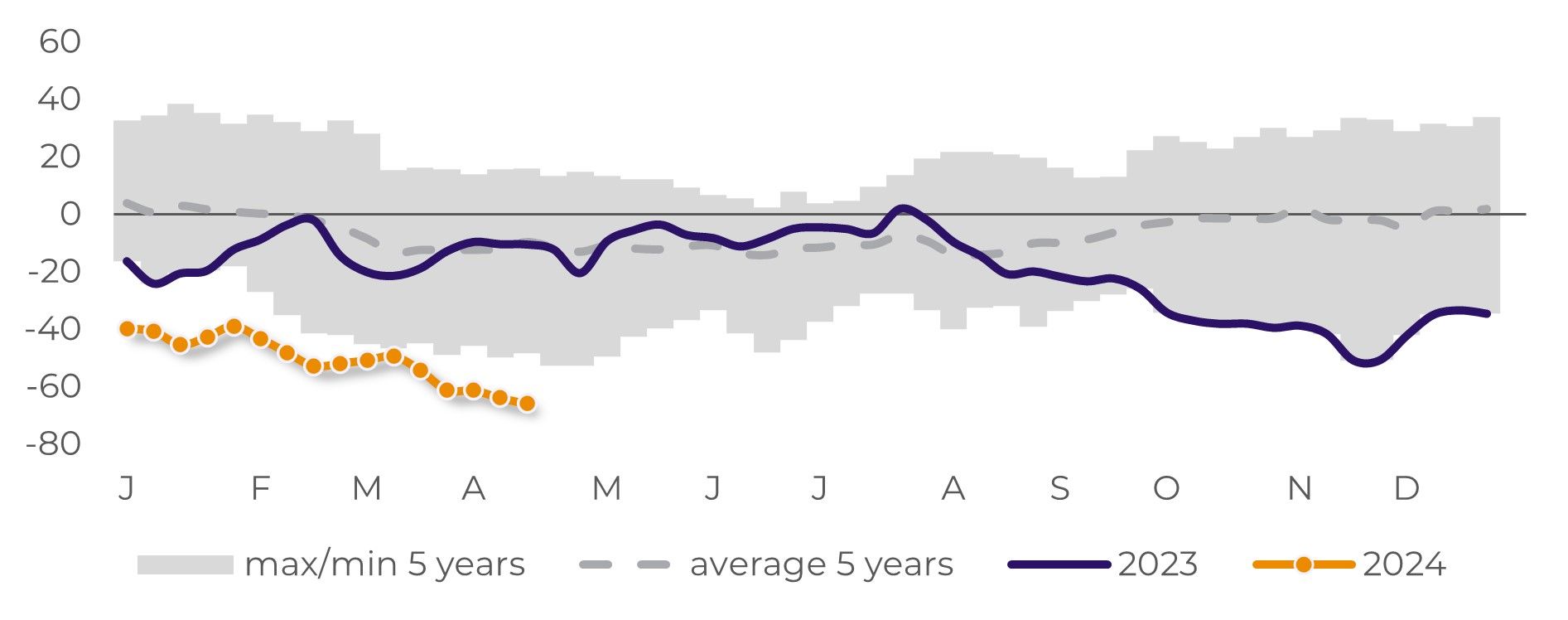
Source: CFTC
Dry weather reduces production estimates
Just as we did in our monthly call last Thursday (18th), Sovecon - a consultancy specialized in the Russian market - also reduced its estimate of Russian wheat production by 1M mt to 93M mt. This was the first reduction in the current cycle, due to deteriorating crop conditions in the south of the country.
Fig. 2: Production, domestic use and exportable surplus - Wheat Russia (M ton)
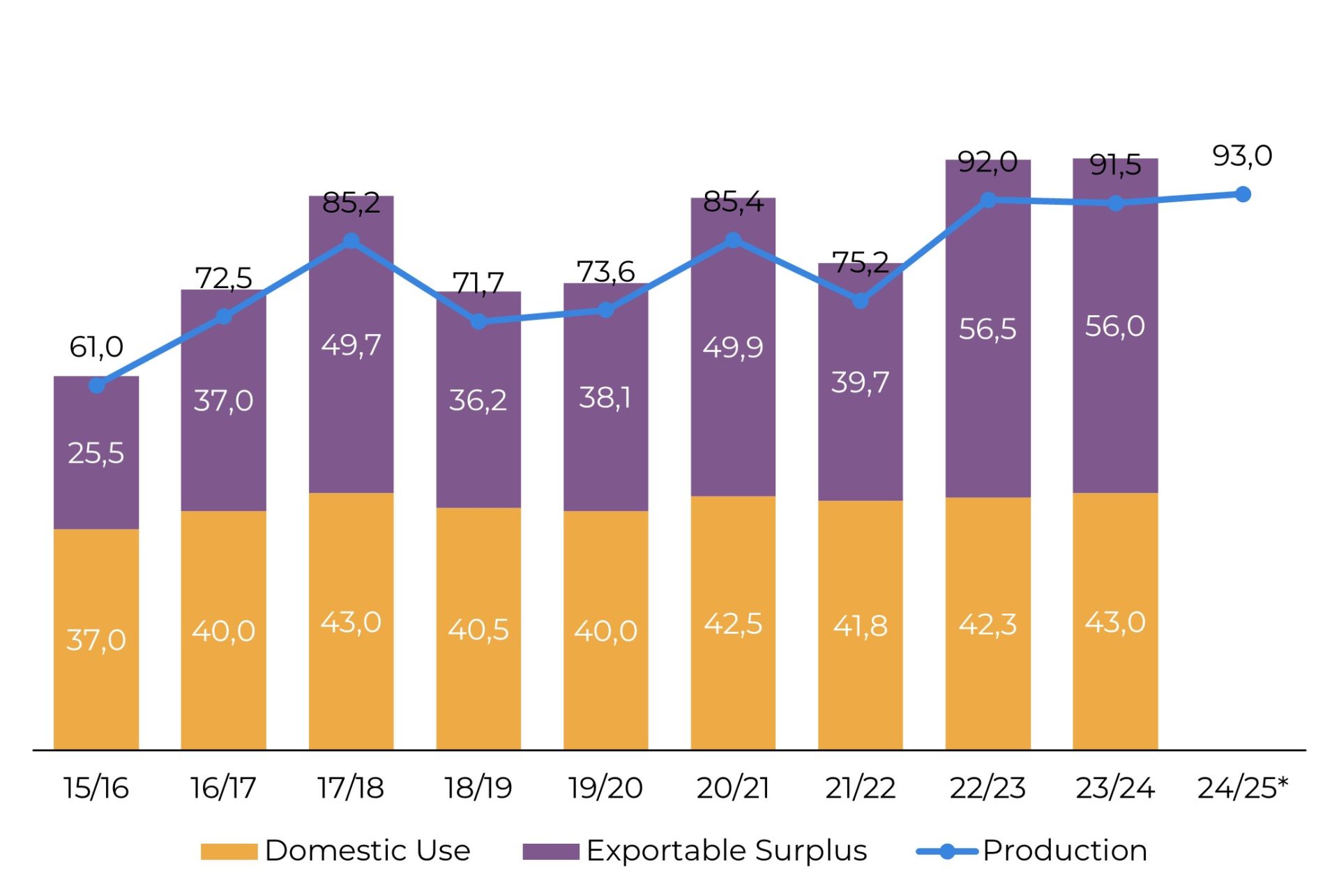
Source: USDA. *Hedgepoint estimate
Southern Russia is the country's largest wheat-producing region, accounting for more than 40% of the total crop. The main reason for the revised estimate is the dry weather conditions in southern Russia.
Over the last 30 days, humidity levels in the region have been between 60 and 80% of normal, with minimum temperatures 2 to 4°C above average. Due to the lack of precipitation, a moisture deficit is forming in the topsoil, and crop conditions have worsened.
SovEcon estimates that harvest conditions is average/slightly above average in Rostov and Krasnodar (Russia's two largest wheat producers) and slightly below average in Stavropol (the third largest).
Fig. 3: Precipitation observed in the last 60 days (% of normal) - Russia
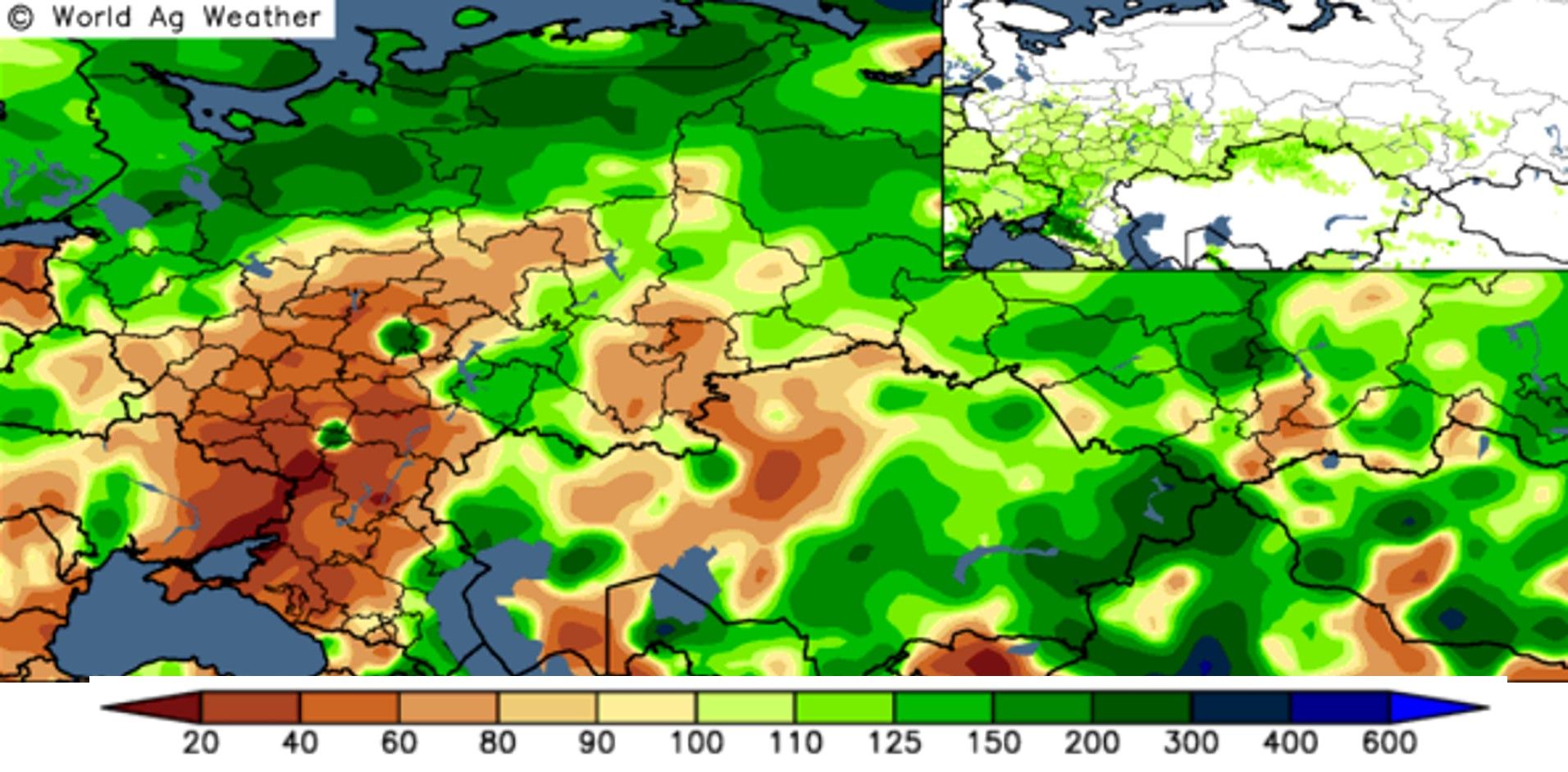
Source: WorldAgWeather
Fig. 4: Soil moisture - southern Russia (% within the top 1 meter)
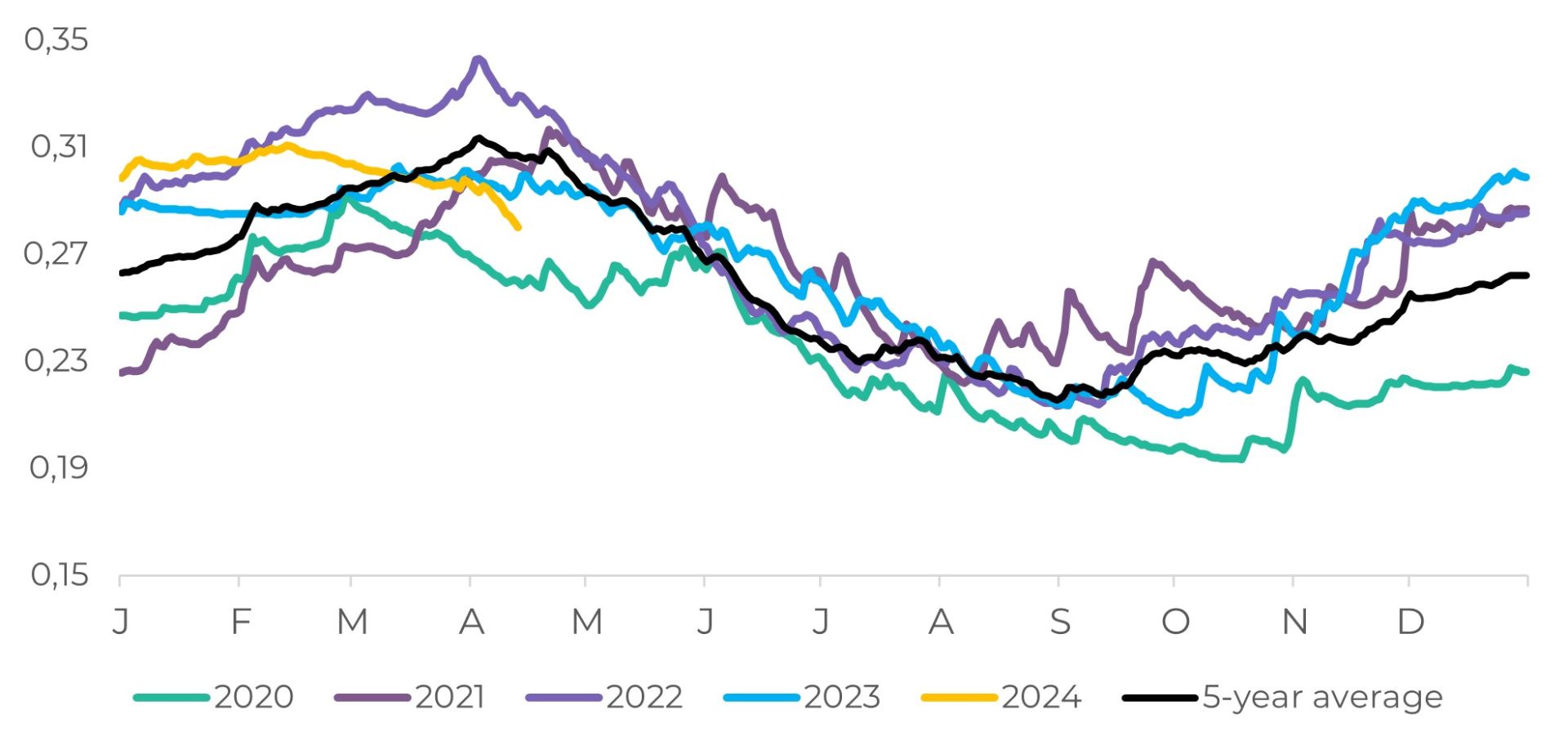
Source: Refinitiv
In the coming weeks, the main weather models predict 60-90% of normal rainfall in the South, which, combined with high temperatures (2-4°C above normal), will probably not significantly improve the availability of moisture for plants in the region.
If the South doesn't receive significant rainfall in the next 2-4 weeks, the region could face a crop failure. However, this could be partially offset by relatively high yields in the Volga region and the Center, where harvest conditions still look better than average.
The weather is also becoming a concern for the country's spring crop, which is due to start being planted next month. Siberia, the main spring wheat producing region, is experiencing soil moisture below the minimums of the last 5 years.
Fig. 5: Rainfall forecast for the next 15 days - Russia (% of normal)
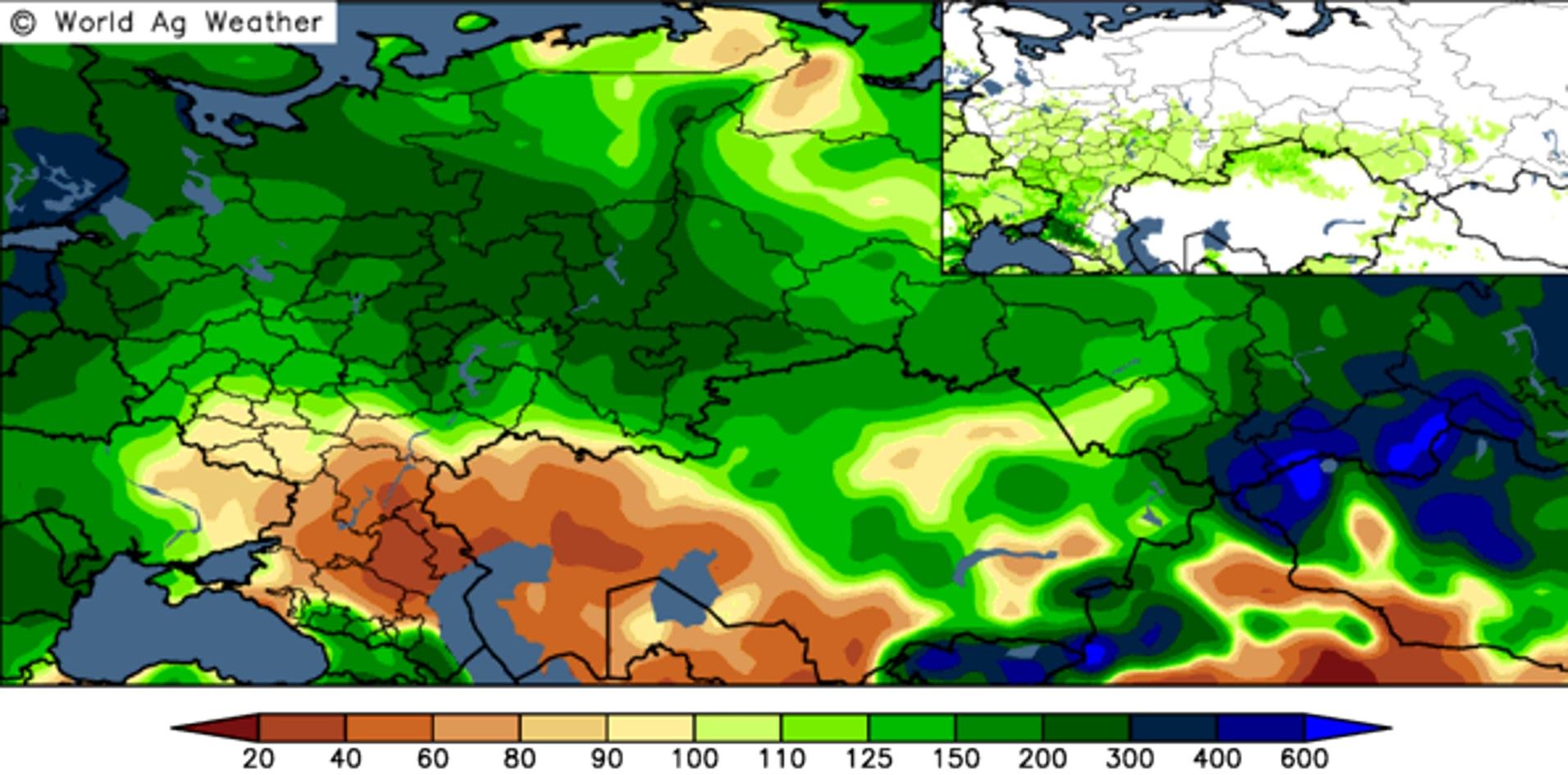
Source: WorldAgWeather
Fig. 6: Soil moisture in Siberia - Russia (% within the top 1 meter)
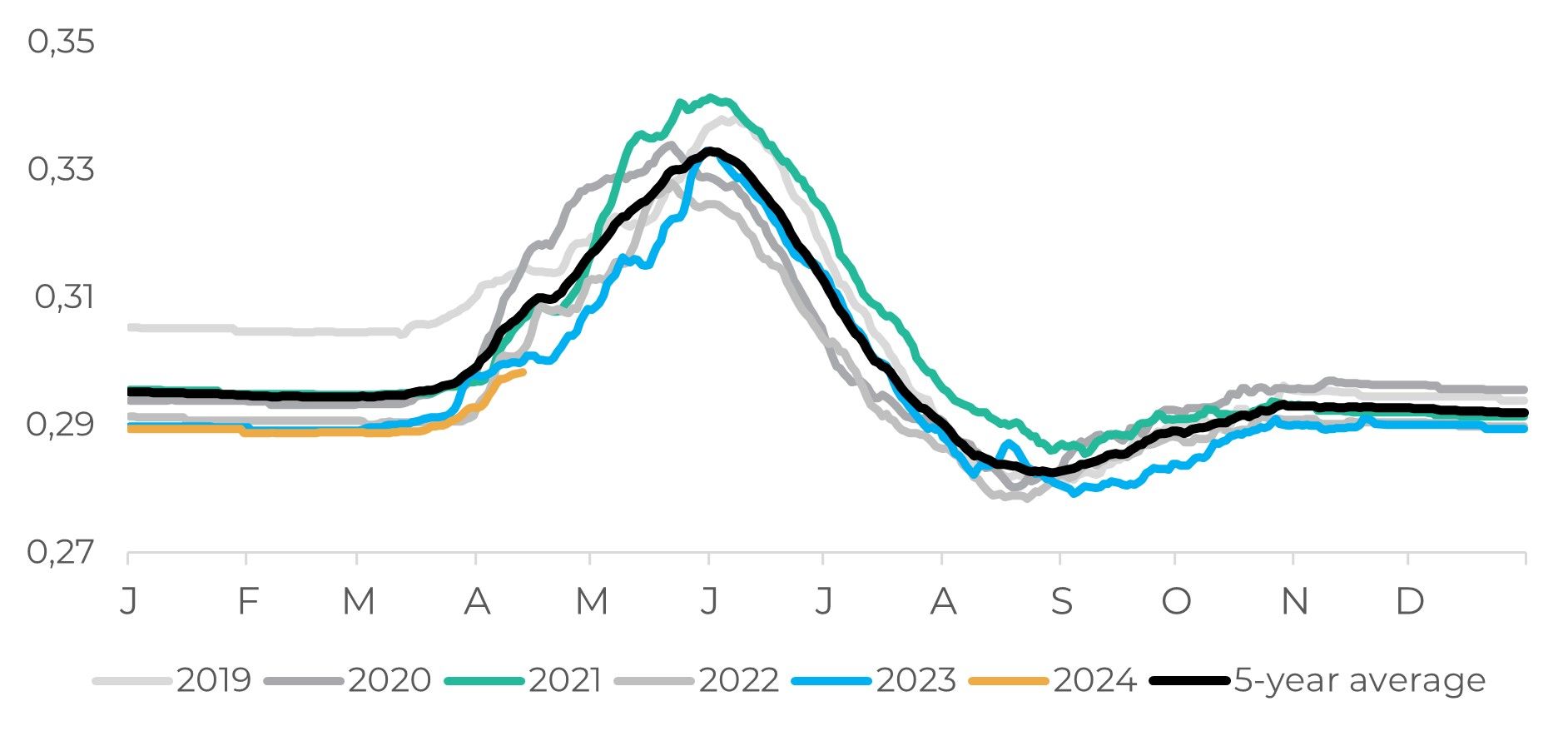
Source: Refinitiv
In summary
The headlines coming out of Russia brought significant upward pressure to wheat contracts this week. In addition to the attacks on Ukrainian port infrastructure - which add risks to the transit of grain on the Black Sea - the market began to worry about the deteriorating conditions of the Russian crop.
Despite the still limited impact on production estimates, there is still room for a significant deterioration in the Russian crop if the weather continues to be negative for productivity. The winter crop won't be harvested until July, and the spring crop will be planted next month. As a result, the harvest in Russia, the main global wheat exporter, could still provide significant support for wheat prices in the coming months.
Fig. 7: Black Sea wheat exports (M ton)
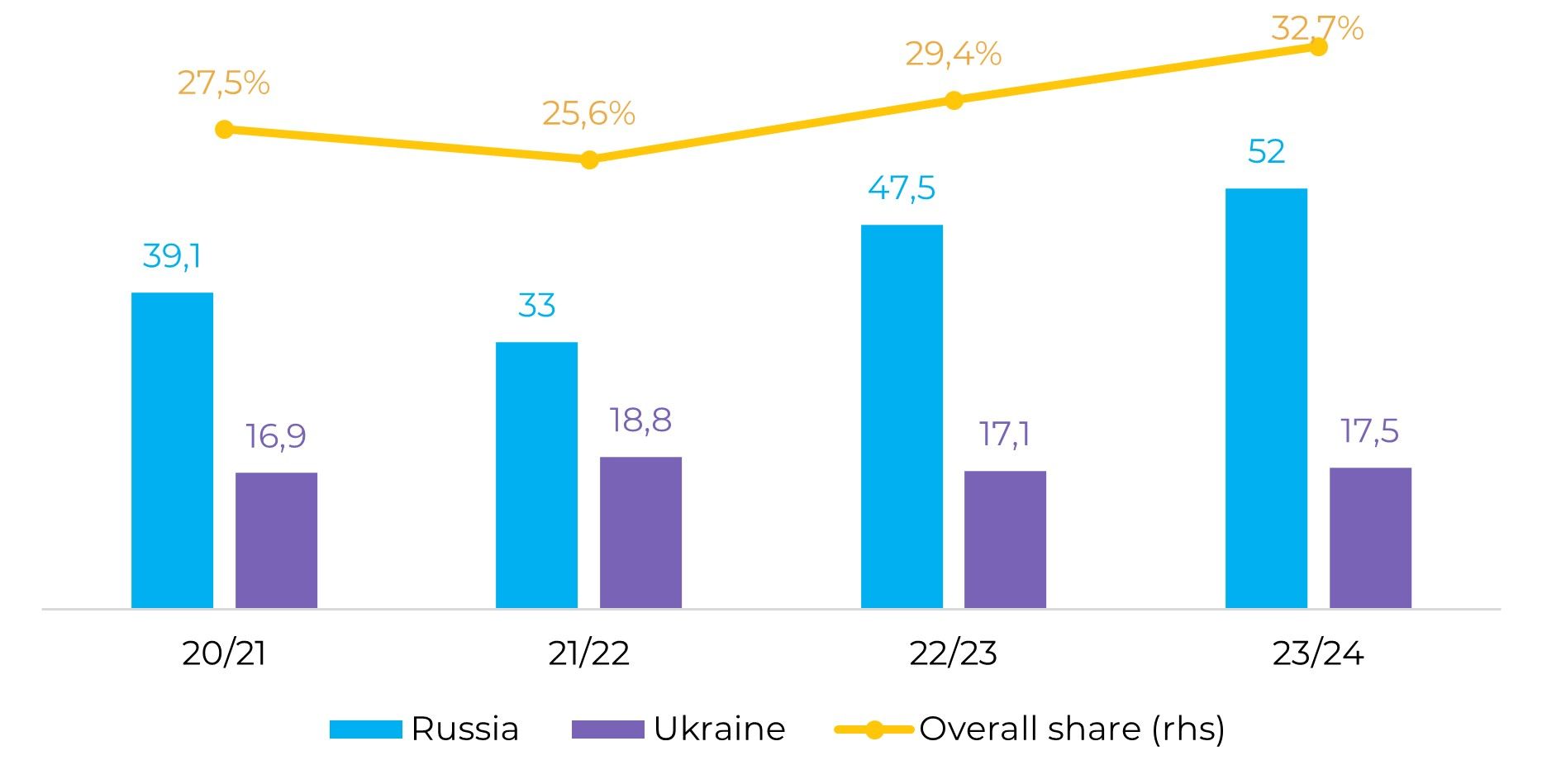
Source: USDA
Weekly Report — Grains and Oilseeds
Written by Alef Dias
alef.dias@hedgepointglobal.com
Reviewed by Laleska Moda
laleska.moda@hedgepointglobal.com
laleska.moda@hedgepointglobal.com
www.hedgepointglobal.com
Disclaimer
This document has been prepared by hEDGEpoint Global Markets LLC and its affiliates ("HPGM") exclusively for informational and instructional purposes, without the purpose of creating obligations or commitments with third parties, and is not intended to promote an offer, or solicitation of an offer, to sell or buy any securities or investment products. HPGM and its associates expressly disclaim any use of the information contained herein that may result in direct or indirect damage of any kind. If you have any questions that are not resolved in the first instance of contact with the client (client.services@hedgepointglobal.com), please contact our internal ombudsman channel (ouvidoria@hedgepointglobal.com) or 0800-878-8408 (for clients in Brazil only).
Contact us
hedgepointhub.support@hedgepointglobal.com
ouvidoria@hedgepointglobal.com
Funchal Street, 418, 18º floor - Vila Olímpia São Paulo, SP, Brasil
This page has been prepared by Hedgepoint Schweiz AG and its affiliates (“Hedgepoint”) solely for informational and instructional purposes, without the purpose of instituting obligations or commitments to third parties, nor is it intended to promote an offer, or solicitation of an offer of sale or purchase relating to any securities, commodities interests or investment products. Hedgepoint and its associates expressly disclaim any use of the information contained herein that directly or indirectly result in damages or damages of any kind. Information is obtained from sources which we believe to be reliable, but we do not warrant or guarantee the timeliness or accuracy of this information. The trading of commodities interests such as futures, options, and swaps involves substantial risk of loss and may not be suitable for all investors. You should carefully consider wither such trading is suitable for you in light of your financial condition. Past performance is not necessarily indicative of future results. Customers should rely on their own independent judgement and/or advisors before entering in any transaction.Hedgepoint does not provide legal, tax or accounting advice and you are responsible for seeking any such advice separately.Hedgepoint Schweiz AG is organized, incorporated, and existing under the laws of Switzerland, is filiated to ARIF, the Association Romande des Intermédiaires Financiers, which is a FINMA-authorized Self-Regulatory Organization. Hedgepoint Commodities LLC is organized, incorporated, and existing under the laws of the USA, and is authorized and regulated by the Commodity Futures Trading Commission (CFTC) and a member of the National Futures Association (NFA) to act as an Introducing Broker and Commodity Trading Advisor. HedgePoint Global Markets Limited is Regulated by the Dubai Financial Services Authority. The content is directed at Professional Clients and not Retail Clients. Hedgepoint Global Markets PTE. Ltd is organized, incorporated, and existing under the laws of Singapore, exempted from obtaining a financial services license as per the Second Schedule of the Securities and Futures (Licensing and Conduct of Business) Act, by the Monetary Authority of Singapore (MAS). Hedgepoint Global Markets DTVM Ltda. is authorized and regulated in Brazil by the Central Bank of Brazil (BCB) and the Brazilian Securities Commission (CVM). Hedgepoint Serviços Ltda. is organized, incorporated, and existing under the laws of Brazil. Hedgepoint Global Markets S.A. is organized, incorporated, and existing under the laws of Uruguay. In case of questions not resolved by the first instance of customer contact (client.services@Hedgepointglobal.com), please contact internal ombudsman channel (ombudsman@hedgepointglobal.com – global or ouvidoria@hedgepointglobal.com – Brazil only) or call 0800-8788408 (Brazil only).Integrity, ethics, and transparency are values that guide our culture. To further strengthen our practices, Hedgepoint has a whistleblower channel for employees and third-parties by e-mail ethicline@hedgepointglobal.com or forms Ethic Line – Hedgepoint Global Markets.Security note: All contacts with customers and partners are conducted exclusively through our domain @hedgepointglobal.com. Do not accept any information, bills, statements or requests from different domains and pay special attention to any variations in letters or spelling, as they may indicate a fraudulent situation.“HedgePoint” and the “HedgePoint” logo are marks for the exclusive use of HedgePoint and/or its affiliates. Use or reproduction is prohibited, unless expressly authorized by HedgePoint. Furthermore, the use of any other marks in this document has been authorized for identification purposes only. It does not, therefore, imply any rights of HedgePoint in these marks or imply endorsement, association or seal by the owners of these marks with HedgePoint or its affiliates.

